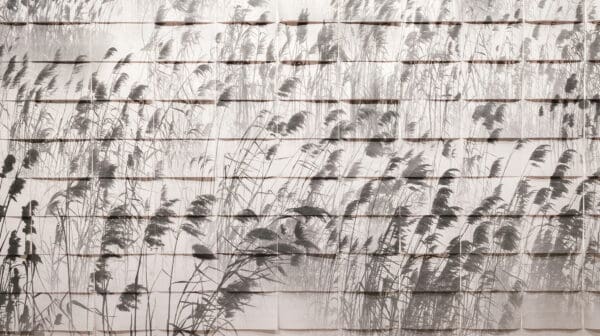
Poetics of Relation
Tender Comrade, currently on show at Sydney’s White Rabbit Gallery, creates a new vocabulary of queer kinship by reimagining the relationship between artworks, bodies and space.
When my editor suggested that I write a year in review column she cautioned me to take it easy on the bad news. We don’t need to be reminded once more that 2020 has been catastrophic. Make it upbeat.
I’ll do my best.
Over the course of the year I’ve written a few columns that attempted to put a positive spin on the situation – be it a lockdown movie viewing guide, how to make life on the internet more pleasant, a call to arms to resist political bastardry, or a piece that recognised just how hard it is for artists to work at any time let alone in the midst of a pandemic – all of them were premised on the idea that we would get through this and come out the other end in a better world.
As I write, the news this morning carried a report that a vaccine was probably a year away for everyday people like you and me. But there is a sense that, in Australia at least, the end is really in sight. The question is what do we want this better world to look like?
I have been reading Kim Stanley Robinson’s latest book The Ministry for the Future, a science fiction novel that attempts to set out a plausible near future history that, while it solves the issue of climate change, outlines a few steps to right the wrongs of the world. With its sunny techno-optimism in mind, I’d like to suggest four achievable things that will make the post-Covid-19 era a place that’s better than the one that went before.
The first is art education. It’s pretty obvious now that the decision to marry art schools with universities was a bad idea to begin with, and it seems to be the irony of ironies that atelier-based art schools look to be the hardiest survivors of 2020. Be they independent artist-run art schools or independent outfits like the National Art School in Sydney, disengagement from the corporate run university sector is now the only viable means of long term survival.
The ray of light here is that this model of art education is infinitely replicable on small to medium scales. As I once argued before in Art Guide, the future of arts education could well be in small, independently-run and separately funded art schools, in community-scaled operations led by individuals or groups of artists, occupying the School of Arts buildings that are spread around country towns and suburbs across Australia.
The second idea goes hand-in-hand with the first – regionalism. If the flight from the cities to the regions that took place in 2020 turns out to be permanent, one of the silver linings of this year will be the fact that a vast number of people interested in the arts will be living in the regions.
Like the people who 20-30 years ago realised getting out of the city was a good idea and set up in small country towns as progressive thinking, latte sipping, red wine drinking holdouts from the oppression of the big cities, these latest arrivals will only make this phenomenon more widespread.
And here is an incredible opportunity to recreate the Australian art world from the ground up, a place of widespread diversity in a range of country towns. The artistic as well as the social impact of this will only emphasise something already known to many people – some of the most exciting creative and cultural work is being done outside of Australian cities.
The third big idea is a little more complicated as it’s predicated on the assumption that the country’s internet connectivity is viable – let’s just for a moment imagine that it is. If the master plan for the next 20 years is about diversification we also have to resist bland conformity – what you might call the Bunnings effect. This could be achieved by an enlightened kind of thinking that engages with the world via the web, but at the same time places a prime cultural focus on local communities and audiences. The spread of Biennale-style events, arts festivals and cultural celebrations in regional centres around the country is testament to the fact that this is already taking place. And the aim is therefore to make them ever more eccentric and unique: events that draw in audiences from afar, but at the same time are focused on the local community they serve.
The fourth and final idea is probably the hardest to achieve and that’s the fight for an equitable art world. Progress towards equality is always difficult as far too many people prefer the status quo, or want to return to ‘normal’ – a real temptation after social upheaval – and it’s hard to say whether social justice can be best achieved via grass-roots community or top-down government actions, although probably both.
But here is the final big idea: fund the art industries to a level commensurate to its contribution to GDP (gross domestic product). Of course money is not the answer to everything but it sure fixes a lot of problems, creates opportunities and sets things in motion. Not even a change of government would probably bring about an idea as radical as this, but funding the arts in the same way that other industries are funded through public money should be considered a birth right and not some far out dream.
One of the real surprises of 2020 was just how fragile many of our social institutions, ways of doing things and customs have proven to be. Yet every crisis provides an opportunity, and if we can conceptualise how we want the world to be, there is a very real chance we can make it so.